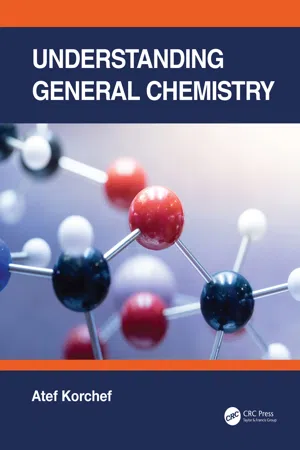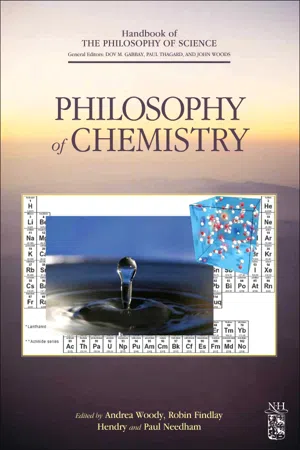Composition of Mixture
Composition of a mixture refers to the proportion of different substances present in the mixture. It is determined by the amount of each component relative to the total amount of the mixture. The composition can be expressed as a percentage, fraction, or ratio of the individual components.
4 Key excerpts on "Composition of Mixture"
- eBook - ePub
- Atef Korchef(Author)
- 2022(Publication Date)
- CRC Press(Publisher)
...A molecule formed by atoms from different elements, such as NaCl and H 2 O, is the building up unit (i.e., the smallest part) of a compound that still has all the properties of that compound. On the other hand, a molecule formed of two or more atoms of the same element, such as H 2, O 2 or O 3, cannot be the smallest part of a compound since a compound consists of two or more different elements that are chemically combined in definite ratios. 1.4.2 Mixtures A mixture is a physical combination of two or more substances (elements or compounds). Substances retain distinct identities. A mixture can be either homogeneous or heterogeneous. A homogeneous mixture is one in which the components are uniformly distributed. The composition of the mixture is uniform throughout Examples: air, seawater, alloys, sugar dissolved in water, chemical solutions (e.g., aqueous solutions of NaCl, NaOH, H 3 PO 4 or KMNO 4, etc.). A solution is a homogenous mixture of two or more substances which are chemically unreactive. A solution is composed of the solute and the solvent. The solute is the substance present in the smaller amount and the solvent is the substance present in the larger amount. When a liquid and a solid form a solution, the liquid is the solvent whatever the amounts of the substances in the mixture. Water is considered to be the most common inorganic solvent, while benzene is the most common organic solvent. All solutions are homogeneous mixtures. Solubility is the property of a solute (solid, liquid, or gaseous chemical substance) to dissolve in a solid, liquid, or gaseous solvent. In thermodynamics, solubility is a physical quantity denoted by “s”, designating the maximum mass concentration of the solute in the solvent, at a given temperature, at which point the solution obtained is said to be “saturated”. A heterogeneous mixture is made up of two or more different substances that remain physically separate. No chemical bonds are formed between the mixed substances...
- eBook - ePub
- Jeffrey Gaffney, Nancy Marley(Authors)
- 2017(Publication Date)
- Elsevier(Publisher)
...The major component is called the solvent, which is commonly a liquid. The minor component is called the solute, which can be a solid, liquid, or gas. The defining property of a solution is that of dissolution. The solute and solvent must interact either physically or chemically in order for a homogeneous mixture to be classified as a solution. The solute will not settle out of the mixture, nor can it be removed by mechanical methods. They can, however, be separated by physical methods involving a phase change of one of the components of the mixture or by chemical methods based on the differences in the chemical properties of the pure substances. Important chemical methods of separation include recrystallization and solvent extraction, which will be discussed in Section 12.4. Although the chemical properties of the solvent and solute are not changed by dissolution, the physical properties of both are altered. So, when a solid solute is dissolved in a liquid solvent, both solute and solvent exist in the liquid phase and the solute then takes on the physical phase of the solvent. The important physical properties of the solvent that are changed by the presence of the solute are colligative properties, properties that depend upon the concentration of solute molecules or ions, but not upon the identity of the solute. Colligative properties include freezing point depression, boiling point elevation, vapor pressure lowering, and osmotic pressure. These will be discussed in Section 12.8. 12.1 Solution Composition The properties and behavior of solutions depend on their composition. Although the composition of a solution can vary from one solution to the next, since the mixture is homogeneous, composition remains the same throughout a single solution. A small sample taken from anywhere in the solution will always have the same composition...
- eBook - ePub
- Dov M. Gabbay, Paul Thagard, John Woods(Authors)
- 2011(Publication Date)
- North Holland(Publisher)
...Mass (weight) is a physical not achemicalproperty. Chemistrymakesuseofconceptssuchasacidity,valency (before Lewis's e lectronic theory of bonding) and so on. Chemical equations, as descriptions of chemical reactions and their products are both qualitative and quantitative. If we consider chemistry only, the elements referred to by the usual symbols are distinguished not only by their chemical properties, that is largely by the reactions they are involved in, but also by the numerical proportions of their constituent atoms. However, such equations do not express the relative masses of the constituents, nor how these masses are distributed as atomic and molecular weights in the course of a reaction. As long ago as the 1850s, Sir Benjamin Brodie [ Brodie, 1866 ] realized that qualitative equations and gravimetric equations were logically distinct. As far as he was concerned the way qualitative and quantitative properties of the chemical elements were correlated was entirely contingent. Armed with the electron/proton model of the atom, and with quantum mechanical tools to relate properties of molecules to those of their atomic constituents, we know better. Arguably our deeper grasp of the origins of chemical properties in the physics of atoms does not dissolve the chemical properties of elements and compounds. In this discussion I will assume the irreducibility of chemical concepts to those of physics. It will be helpful at this stage of the analysis to introduce the distinction between heterogeneous and homogeneous regresses. To explain the behaviour of a piece of glass rubbed with a silk cloth we say that it has become positively charged. However, when challenged to explain the phenomenon we advert to the charge on elementary particles, the electron and the proton. When the phenomena associated with charge at one level are explained by citing the same concept, ‘charge’, at a deeper level, that is a homogeneous regress...
- eBook - ePub
Foundations for Teaching Chemistry
Chemical Knowledge for Teaching
- Keith S. Taber(Author)
- 2019(Publication Date)
- Routledge(Publisher)
...These are common alternative conceptions and are not just issues in the classroom, as such ideas are often found in the general population and may influence consumer behaviour. Teaching an important distinction In terms of meeting teaching objectives, we need students to draw a distinction between materials that are found around us and the component substances from which they are composed. This is perhaps an issue of complexity: in chemistry we look at the simple cases of individual substances (which are often interesting and challenging enough) which can inform the more complex cases of materials: materials that often contain many different substances, sometimes arranged in complex ways (e.g., consider how different compounds are ‘organised’ in a piece of wood). Figure 7.1 Being natural does not necessarily imply being safe and healthy There is a teaching narrative here that when we examine the materials found in the world, we often find that we can break them down and separate them into a number of different substances, and sometimes the same substance may be a component of quite different materials (see Figure 6.2). As many materials are basically mixtures, where there can be variable composition, studying the substances offers a less complex starting point for understanding the material world. Of course, this is not an entirely satisfactory account, as there are at least two major caveats to this narrative. One is that it might imply chemistry has a simpler task than a more general material science because it is able to examine the few different substances from which all the materials of the world are composed. This would be a little disingenuous, given the vast catalogue of substances that chemists have studied: hardly a handful of basic building blocks of matter! The second complication is that sometimes we can extract different substances from a material simply by separating out a mixture...



